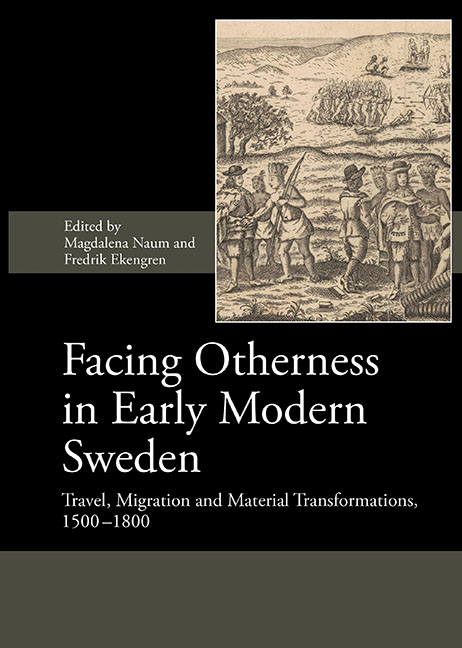Book contents
- Frontmatter
- Contents
- List of Illustrations
- List of Contributors
- Preface
- List of Abbreviations
- I Material Transformations
- II Migration and Neighbourly Interactions
- Introduction
- 6 Marrying “the Other”: Crossing Religious Boundaries in the Eastern Borderlands of the Kingdom of Sweden in the 17th Century
- 7 Ideas from Abroad: German Weavers as Agents of Large-Scale Cloth Production and a Continental Lifestyle in 17th-Century Sweden
- 8 Foreign Merchants in Early Modern Sweden: A Case of Intermarriage, Trade and Migration
- 9 Aspects of “British” Migration to Sweden in the 17th Century
- 10 Commodities, Consumption and Forest Finns in Central Sweden
- 11 Encountering “the Other” in the North – Colonial Histories in Early Modern Northern Sweden
- 12 Lapland's Taxation as a Reflection of “Otherness” in the Swedish Realm in the 17th and 18th Centuries: Colonialism, or a Priority Right of the Sami People?
- III Overseas Travel
- IV Conclusions
- Index
9 - Aspects of “British” Migration to Sweden in the 17th Century
from II - Migration and Neighbourly Interactions
Published online by Cambridge University Press: 23 July 2019
- Frontmatter
- Contents
- List of Illustrations
- List of Contributors
- Preface
- List of Abbreviations
- I Material Transformations
- II Migration and Neighbourly Interactions
- Introduction
- 6 Marrying “the Other”: Crossing Religious Boundaries in the Eastern Borderlands of the Kingdom of Sweden in the 17th Century
- 7 Ideas from Abroad: German Weavers as Agents of Large-Scale Cloth Production and a Continental Lifestyle in 17th-Century Sweden
- 8 Foreign Merchants in Early Modern Sweden: A Case of Intermarriage, Trade and Migration
- 9 Aspects of “British” Migration to Sweden in the 17th Century
- 10 Commodities, Consumption and Forest Finns in Central Sweden
- 11 Encountering “the Other” in the North – Colonial Histories in Early Modern Northern Sweden
- 12 Lapland's Taxation as a Reflection of “Otherness” in the Swedish Realm in the 17th and 18th Centuries: Colonialism, or a Priority Right of the Sami People?
- III Overseas Travel
- IV Conclusions
- Index
Summary
While Scottish migration to Sweden has been extensively researched in recent years there has been little scholarship undertaken concerning migrants from other areas of Britain. This chapter therefore draws on established research on Scottish migration to Sweden in this period, as well as recent research focusing on the experience of English migrants. In comparing the experiences of the two, both continuities and differences will be examined, with the possibility of an extant “British” migrant community investigated. The chapter uses case studies ranging across the 17th century, focusing on areas in mainland Sweden as well as in Swedish Baltic possessions.
The contribution of foreigners to the development of Sweden during the 17th century has been firmly established for some time. The roles of Dutch and German migrants have been singled out in particular. However, an appreciation of the significance of Scottish immigration to Sweden in this period is much less widespread, and development of this has been largely left to the efforts of Scottish historians in recent times. Comprehension of the role played by the English has remained largely overlooked. Continuing the study of British migrants to Sweden during this period advances our understanding of migrant groups as a whole. By viewing the experience of the English and Scots we increase our knowledge of mobility during the period. This is achieved in two respects: in regard both to mobility through migration and mobility through social elevation. We also begin to touch upon ideas of interaction in several ways: how the British elements of Swedish migrant communities interacted with members of their host society, as well as with other foreign ethnicities and members of their own nation. Furthermore, the study of British migrants enriches our understanding of Sweden as a place of cultural diversity and a centre of impact of foreign activity.
This chapter outlines some of the key features in the historiography of British migration to Sweden in the 17th century. The discovery of unexploited archival material in Sweden, as well as the undertaking of a new research project focusing on Anglo-Swedish trade in this period, warrants an evaluation of the subject. The chapter therefore seeks to readdress previous conclusions, whilst querying how new material might add to present understandings.
- Type
- Chapter
- Information
- Facing Otherness in Early Modern SwedenTravel, Migration and Material Transformations 1500–1800, pp. 169 - 186Publisher: Boydell & BrewerPrint publication year: 2018

